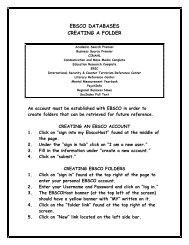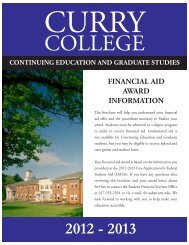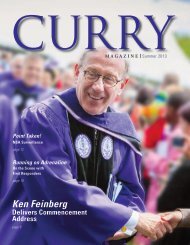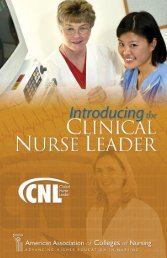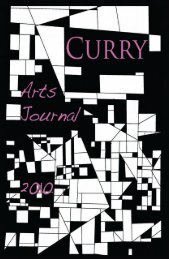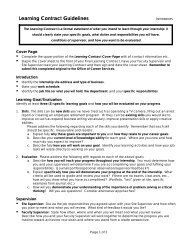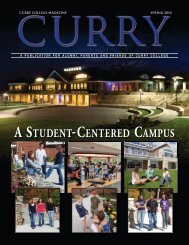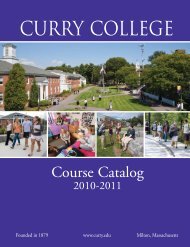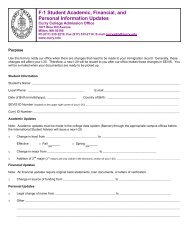Read the Curry College NEASC 2012 Self-Study Report.
Read the Curry College NEASC 2012 Self-Study Report.
Read the Curry College NEASC 2012 Self-Study Report.
You also want an ePaper? Increase the reach of your titles
YUMPU automatically turns print PDFs into web optimized ePapers that Google loves.
63<br />
The large‐scale impact of <strong>the</strong>se efforts on <strong>the</strong> overall retention rate has not yet been assessed.<br />
Some of <strong>the</strong> very recent changes, including reduction in <strong>the</strong> number of students with less than<br />
a 2.0 high school GPA and earlier invention with at‐risk students, are anticipated to have a<br />
positive impact on future retention rates. Sustainable improvements are <strong>the</strong> longer‐term goals,<br />
and <strong>the</strong>y will be based on analyses of <strong>the</strong> impact of interventions such as those noted above on<br />
student learning, engagement, retention and graduation. The appointment of an institutional<br />
research director has provided an important resource for more sophisticated data analyses to<br />
better align and direct institutional efforts on retention and student learning.<br />
To fur<strong>the</strong>r its commitment to data‐driven decision‐making, <strong>the</strong> <strong>College</strong> is also considering ways<br />
to best execute and oversee comprehensive and systematically aligned efforts. One possibility<br />
may be through changes to <strong>the</strong> existing organizational structure, which is now configured such<br />
that Admissions, Financial Aid, and Enrollment Management report to <strong>the</strong> President through<br />
three separate members of Senior Staff (Dean of Admission, Chief Financial Officer, and Chief<br />
Academic Officer). There is recognition of <strong>the</strong> critical need for integrated oversight and<br />
leadership of retention efforts to make significant progress on an issue that is critical to <strong>Curry</strong>’s<br />
success.<br />
Student Services<br />
The comprehensive array of services, leadership, athletic/recreational, and co‐curricular<br />
opportunities provided to <strong>Curry</strong> students helps <strong>the</strong> <strong>College</strong> to meet its goal of supporting <strong>Curry</strong><br />
students to succeed and flourish within its academic environment. Guided by an assessmentoriented<br />
framework, <strong>Curry</strong> regularly evaluates its student services offerings to determine what<br />
improvements can be made to fur<strong>the</strong>r increase student engagement and success. The following<br />
are examples of ways that both formal and informal data have been used to revise and improve<br />
student services and inform appraisal of existing activities.<br />
• Noel‐Levitz Student Satisfaction Surveys yield consistently high ratings for <strong>Curry</strong> as a<br />
caring community. However, when responses indicated concerns with public safety,<br />
significant attention and resources were brought to bear to improve <strong>the</strong> professionalism<br />
and consistency of <strong>the</strong> Public Safety Office. Now under new leadership, <strong>the</strong> Public Safety<br />
Office receives praise from students, although not yet as consistently favorable ratings<br />
as o<strong>the</strong>r college services.<br />
• The <strong>College</strong>’s strategic planning survey indicates that traditional undergraduates are<br />
most satisfied with academic support, academic advising, leadership opportunities and<br />
technology in <strong>the</strong> classroom, and are less satisfied with technology in <strong>the</strong> residence<br />
halls, residential facilities, and campus safety. Supplementing that information are<br />
results from a Residence Life and Housing survey, conducted in 2010, to assess<br />
satisfaction with First Year Residence Halls; 21% of <strong>the</strong> population responded,<br />
identifying several <strong>the</strong>mes: dissatisfaction with <strong>the</strong> condition and maintenance of <strong>the</strong><br />
residence halls, lack of adequate common lounge space, frustrations with damage and<br />
vandalism by peers, and lack of adequate wireless internet in <strong>the</strong> halls. Some action<br />
items that came from <strong>the</strong> process included a review of <strong>the</strong> damage billing process and<br />
practice, requests to update common space appearances, and a commitment to<br />
<strong>Curry</strong> <strong>College</strong> <strong>2012</strong> <strong>Self</strong>-<strong>Study</strong><br />
Standard Six



